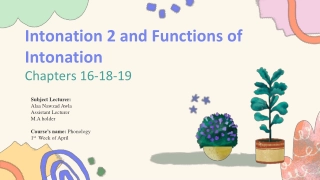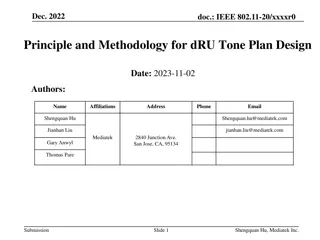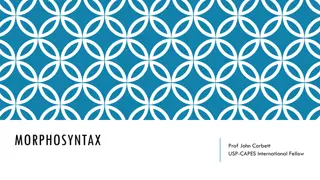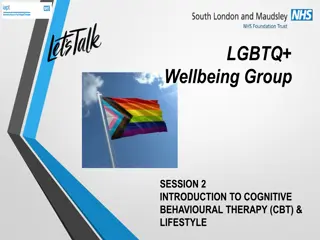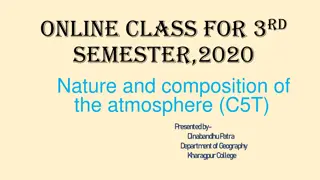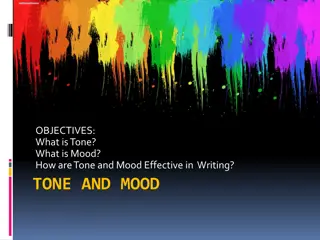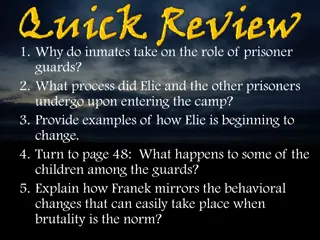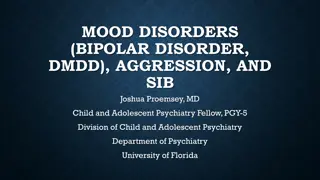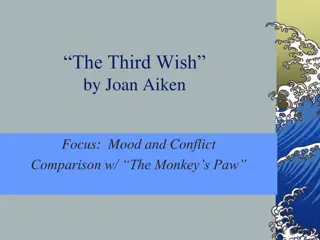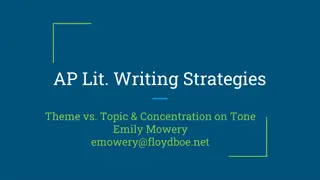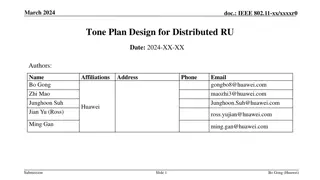Understanding Tone, Mood, and Atmosphere in Literature
Atmosphere, mood, and tone are essential elements in literature that shape the emotional tone of a literary work, influence reader expectations, and convey the author's attitude. They are interconnected yet distinct aspects that add depth and complexity to storytelling. This analysis delves into the nuances of identifying and interpreting atmosphere, mood, and tone through examples from literary passages.
Download Presentation

Please find below an Image/Link to download the presentation.
The content on the website is provided AS IS for your information and personal use only. It may not be sold, licensed, or shared on other websites without obtaining consent from the author. Download presentation by click this link. If you encounter any issues during the download, it is possible that the publisher has removed the file from their server.
E N D
Presentation Transcript
TONE, MOOD, ATMOSPHERE GROUP 2 63718020 DINAN FUZIANTI 63718010 MELVA PANGESTU 63718007 RIMA MARDIYANI 63719004 MUHAMMAD LUTHFI NURJAYA
Atmosphere - is the emotional tone pervading a section or the whole of a literary work, which fosters in the reader expectations as to the course of events, whether happy or (more commonly) terrifying or disastrous (Abrams, M. H ) - their on, but in their association with characters actions, thought, feelings, and expereiences. (Rib , I.) the arrangement or representation of natural and artificial things, not as the stand on
Mood The alternative terms frequently used for atmosphere (Abrams, M. H)
Tone - Tone as the expression of literary speaker s attitude to his listener . (Abrams, M. H) - Tone was defined as the content and form, or manner, in which the story is told (Dwyer, R., & Davis, I.)
Chapter 5 : Nick invite Diasy to have a tea and they both visited Gatsbys place Chapter 6 : Tom & Daisy came to Gatsby Party. Gatsby want Daisy to come back to him. Chapter 7 : Nick & Jordan come to Tom & Daisy s place to have a lunch and Gatsby pursued Daisy to tell tom that she didn t love him but gone wrong and Daisy freak out untill she nabrak Myrtle Chapter 8 : Gatsby wait for Daisy s call but he found dead at his pool Chapter 9 : Nick call every Gatsby s closest person to come to Gatsby furneral
ATMOSPHERE TO IDENTIFY ATMOSPHERE, USUALLY THE NARRATOR HAVE A THIRD PERSON SPEAKER TO DESCRIBE THE SITUATION. IT WOULD DESCRIBE THE PLACE SITUATION OR THE SURROUNDER SO THE READER CAN FEEL IT. From the passage, Nick described the situation where Myrtle dead and her dead body wrapped in a blanket as it surrounded by people. Wilson, the husband of Myrtle seat in his office look so frustated. Atmosphere : Gripping
TONE THE TONE COULD BE FORMAL AND INFORMAL. IT CAN BE IDENTIFIED BY THE ATTITUDE THAT AUTHOR WANT TO DELIVER. TONE CAN BE SEEN FROM THE DIALOGUE OF A CHARACTER THAT SHOW THE EXACT EMOTION. In the first passage, Tom was declining the idea about Daisy who didn't love him, from the way he talked it can be seen that he was filled with emotion. The tone in this moment are furious and jealous. Meanwhile in the second passage shown the conversation between Nick and Gatsby. The tone of this can be seen from Gatsby s who is flustered
MOOD MOOD ARE RELATED WITH ATMOSPHERE AND TONE. BUT THE MOOD DEFINED AS THE EMOTION THAT THE READERS CAN FEEL. IT CAN BE IDENTIFIED BY THE DESCRIPTION, MONOLOGUE AND DIALOUGE FROM TWO CHARACTERS. From the passage, when Daisy and Gatsby came to a place and there are just the two of them. As the readers we could feel the romantic and affection from both of them.
Relation between Atmosphere, Tone & Mood. Tone Atmosphere Mood
REFERENCE Rib , I. (2019). Prose Fiction: An Introduction to the Semiotics of Narrative. Dwyer, R., & Davis, I. (Eds.). (2016). Narrative research in practice: Stories from the field. Springer. Abrams, M. H., & Harpham, G. (2011). A glossary of literary terms. Cengage Learning.


